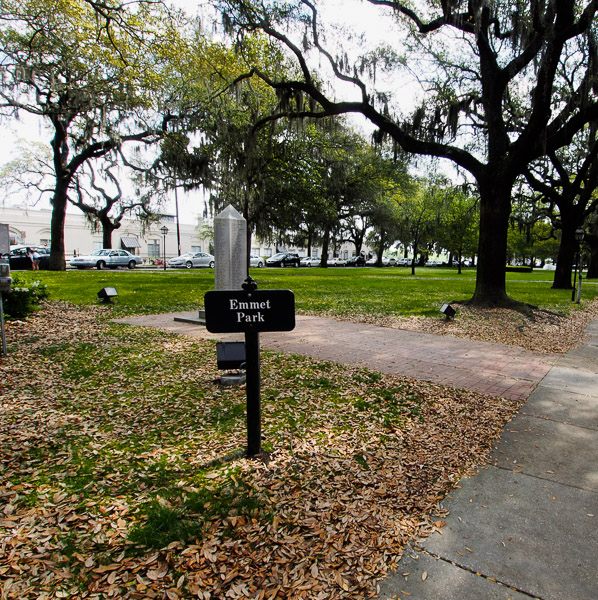 Emmet Park
Emmet Park
Emmet Park
 Emmet Park
Emmet Park
Emmet Park
Savannah, GA 31401
Emmet Park is a beautiful, tree-shaded park located on the bluff overlooking the Savannah River. Emmet Park was once known as the "Strand" and later as "Irish Green" because of its proximity to the Irish residents of Savannah's Old Fort neighborhood. The park was later renamed, in 1902, for the Irish patriot Robert Emmet (1778-1803 ) to commemorate the centennial of his death. Emmet had led an unsuccessful Dublin uprising for Irish independence and was executed for treason. Robert Emmet became a hero to Savannah's Irish community. A Celtic Cross sits in the grassy strip on the bluff overlooking the Savannah River. Emmet Park remains an important center of ceremonial congregation for Savannahians of Irish descent.
There are several points of interest in or within walking distance of the park including the Harbor Light, which was built in 1852 to help guide vessels around the wrecks of ships sunk by the British in 1779.
The following monuments and memorials are located in the park.
- Celtic Cross
- Chatham Artillery Monument
- Vietnam Veterans Memorial
- Salzburger Monument of Reconciliation
- Chatham Artillery Monument
- Irish Memorial
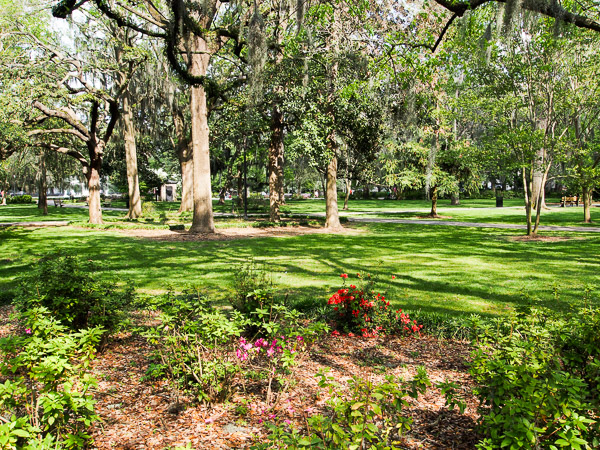 Forsyth Park
Forsyth ParkForsyth Park
Savannah, GA 31401
Forsyth Park is the largest park in the historic district of Savannah Georgia. It was originally created in the 1840s on 10 acres of land. In 1851, the park was expanded and named for Georgia Governor John Forsyth. Mr. Forsyth also donated 20 acres of his land to increase the park to occupy 30 acres in the historic district of Savannah. The park is bordered by Gaston Street on the North, Drayton Street on the East, Park Avenue on the South and Whitaker Street on the West. Forsyth Park is located at the southern edge of the Historic District.
Forsyth Park is a hub of social interaction. There are people playing recreation sports, sun bathing, enjoying picnics, reading or just relaxing. On Saturdays there is a great Farmer’s Market.
Today Forsyth Park features walking paths, open areas, beautiful tree cover, a fragrance garden and Savannah's magnificent Confederate Monument.
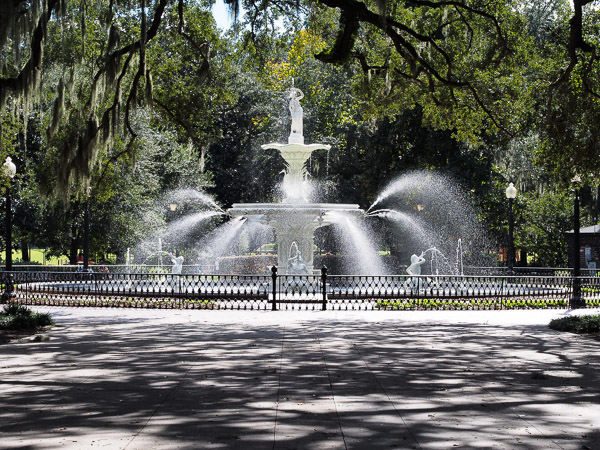 Forsyth Fountain
Forsyth FountainForsyth Fountain
The most popular feature of Forsyth Park is the large fountain that sits at the north end of Forsyth Park. The fountain was built and added to Forsyth Park in 1858. It resembles fountains in Paris and Peru. Every year on St. Patrick’s Day the city of Savannah dyes the water in the fountain green in celebration of Savannah's deep Irish heritage.
All around the Forsyth Park Fountain are benches. On any given day you can find many people, especially locals, lounging on the benches, relaxing, reading or taking in the scenery.
 Confederate Monument
Confederate MonumentConfederate Monument
The Confederate Monument is one of the largest Confederate monuments and is located at the far end of Forsyth Park pass the fountain. This impressive monument honored local Civil War veterans as well as those who had lost their lives in the bloody conflict. The Confederate Monument was erected in Forsyth Park in 1879.
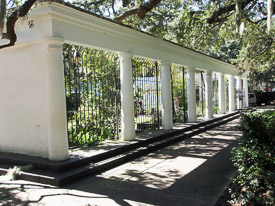 Fragance Garden |
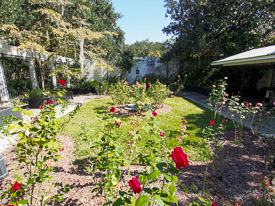 Interior of the Fragrance Garden |
Fragrance Garden
Just southwest of the fountain is the Fragrant Garden for the Blind. It was created by the Trustees Garden Club of Savannah and has been around since 1963, but has only recently been opened to the public A treat for the senses, the plant name plaques also feature Braille writing. The garden is open 9am to 2pm Monday through Friday.
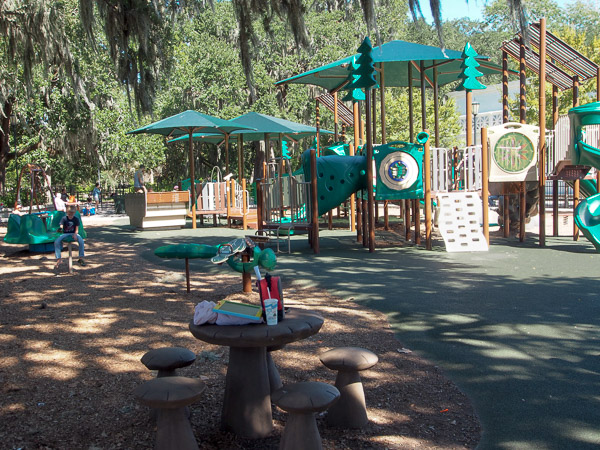 Forsyth Park Playground
Forsyth Park Playground
Forsyth Park Playground
For children, there is a modern, well-equipped, fenced-in playground that will keep any child entertained for hours.
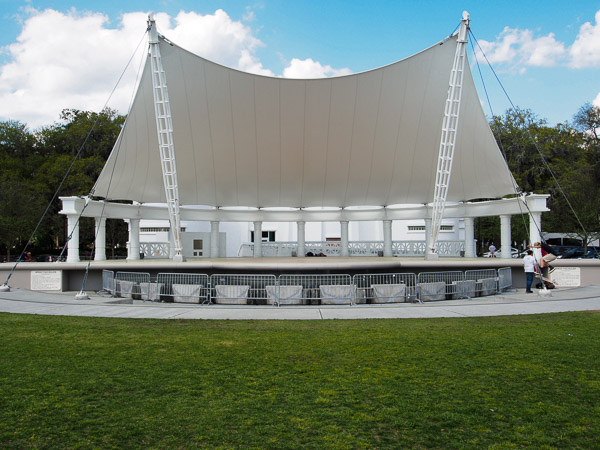 Forsyth Park Pavilion
Forsyth Park Pavilion
Forsyth Pavilion
Many activities and concerts are held at the Forsyth Pavilion.
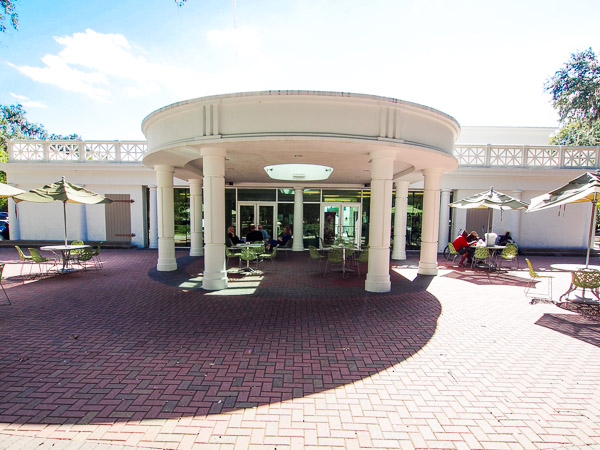 Forsyth Cafe
Forsyth Cafe
Forsyth Cafe
Neighboring the Fragrant Garden is one of the park’s newest additions – the Forsyth Park Visitor’s Center, which was opened in 2009. The center consists of a stage, fountain and café. The stage, complete with a band shell, is the venue for many of Savannah’s public concerts and events. The café is great for a fresh sandwich or salad, coffee, tea or bottle of water.
 Salzburger Park
Salzburger Park
Salzburger Park
Bay Street between Lincoln & Abercorn Streets
Savannah, GA
Salzburger Park is adjacent to Emmett Park on Bay Street. The park is a about a 1/2 acre and is marked by a sign, The Salzburger Monument of Reconciliation and its historical marker. The Salzburger Monument of Reconciliation was shipped from Austria and was presented to the City of Savannah in 1994. The Salzburger Monument pays tribute to the Lutheran Protestants who sought religious freedom in Georgia after being expelled from their homeland. The first group of German-speaking Lutherans, known as the Salzburgers, landed near the monument site in 1734 and soon settled in Ebenezer, north of Savannah.